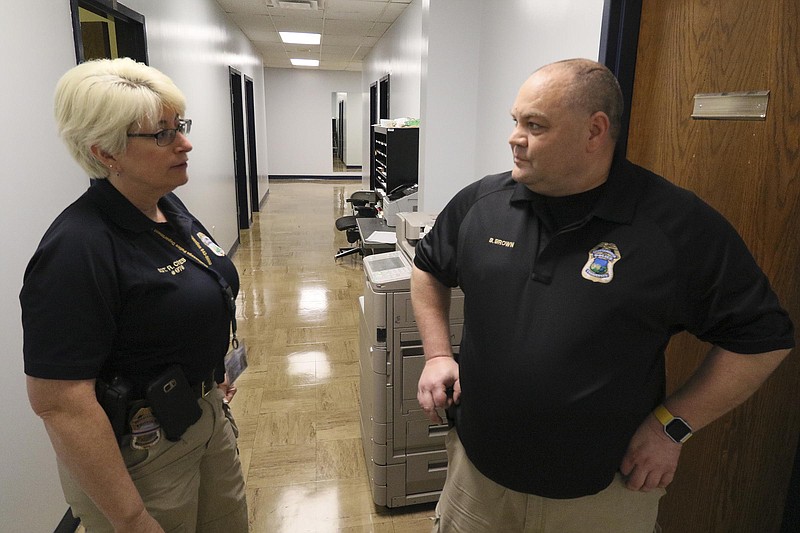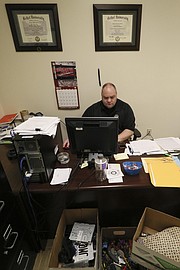For Chattanooga police detective Brad Brown, work can get personal.
Brown specializes in thefts from storage buildings - a hot target for thieves - and his own unit in Hixson was among several at the same location broken into recently.
Brown recognized the burglars' method of operation immediately: they had rented a unit themselves to obtain the access code for the building and then, once inside, sawed through the padlocks on several units, replacing them with their own locks so no one would notice anything was wrong.
"A lot of storage buildings don't have cameras on the inside," Brown said. "And it is not unusual for people to go six months without checking their storage unit."
That gives thieves plenty of time to remove items at their leisure.
While shootings get most of the attention and police focus in Chattanooga, many more people are affected by property crimes.
"Violent crime or shootings probably directly impacts 1 to 3 percent of the public," Brown said. "Property crimes probably affect closer to 70 or 80 percent of the public, myself included."
But the ranks of the Chattanooga Police Department's burglary unit have shrunk in recent years as officers have been moved to confront the city's persistent rash of shootings.
The unit is now using college criminal justice interns and volunteers to do some of its paperwork and give the five detectives more time out on the streets, said Lt. Craig Joel, who is Brown's boss.
The unit has far more work than it can handle, 100-200 new cases every month, Joel estimates, but unfortunately, "nine times in 10, the property crime report is presented with no witnesses, no leads, and no evidence."
That doesn't mean the case is impossible to solve, he said. If the thieves use a stolen credit card at a local business, surveillance video may provide a lead. Security cameras are a lot better than they were even 10 years ago, Joel said.
Brown believes most break-ins and thefts are committed by people looking for quick money to buy drugs.
"A majority are on meth [methamphetamine], and a small percentage are on heroin," he said.
He prefers the heroin users.
"If they are on meth, they will be awake for two or three days breaking into things. But we had a street full of car break-ins and we went down the street and found all three of [the thieves, who were heroin users], all passed out. Heroin makes it easier."
Brown believes storage unit thefts and thefts from automobiles are interconnected.
"The people who break into cars and storage units are intertwined," he said. "They often do not break into houses or buildings because, in their meth mind, it is committing less of a crime if they are not breaking into homes."
Brown's work is personal for another reason beyond his status as a victim. He and other property unit officers believe many of the thefts he investigates are committed by a handful of professionals, many of whom he has come to know, at least by reputation.

"It would not be unusual to be able to name 20 people who commit the majority of property crimes in this city and surrounding areas," Joel said.
Many of those regulars have a larger group of affiliates, Brown said.
"They're organized. The majority are from North Georgia in a group of 100 people. They run it like a hierarchy. This one breaks into cars, this one steals cars, these do drugs, these do storage units," he said.
Police officers stumbled onto one group by accident, Brown said. The manager of a motel in East Ridge was worried that a group of people who had been staying at the motel for some time were damaging their rooms, but he was afraid to try to evict them without having police officers present.
When the officers went to the door of one room, they could see "a dozen laptops and 50 cellphones," Brown said, so they quickly got a search warrant. "There were seven rooms with stolen property in them," he said.
"The scary part was, those seven rooms were probably from their last week or two of work," Brown said. "If they are getting that much for a week or two, imagine how much they were taking over three months."
Until relatively recently, storage unit and auto break-ins were a low priority for police investigators. But then they realized that the items stolen in those break-ins often allowed thieves to steal identities and commit other crimes. With a purloined title, thieves could steal a car and quickly move it to a neighboring state and obtain a new registration.
If thieves have stolen check stubs and a fake ID, they can take them to so-called "payday loan" shops and borrow $200, often hitting several such stores in a day.
Over a year ago, police departments across the U.S. discovered the Felony Lane Gang, a Ft. Lauderdale, Fla., based gang that specializes in stolen credit cards and identity theft.
The name comes from the gang's habit of using the drive-up teller windows at a bank to cash counterfeit checks, always pulling up to the "felony lane"- the lane the farthest from the teller window. The lane gets that nickname because it is preferred by people trying to use fake IDs to cash checks, Brown said, because it is hard for the tellers to see them clearly.
Gang members specialize in hitting storage units and in thefts from autos, good places to find valuable documents that can be used for ID theft.
But because they often use social media to keep in touch or brag of their exploits, they often give themselves away to the police.
One Felony Lane member, a young woman, used a fake Facebook page on which everything was made up except her photo and, inexplicably, where she went to high school in Florida, Brown said. He contacted the local police department, who showed her photo to high school officials, who quickly identified her. On another occasion, a suspect went to the Facebook page set up by the Felony Lane Task Force, a group of police officers and detectives, and wrote "Liar" as a comment on something posted there about the gang, revealing her own Facebook page and identifying herself to officers as a suspect.
On other occasions, convicted felons have posted photos of themselves posing with guns, something that is a parole violation, Joel said.
Neither Brown nor Joel, however, will go into detail about other ways detectives use social media in investigations.
But the internet also helps thieves, making it easier to sell goods on online yard sale sites, for example.
"It's difficult because there are so many of them," Brown said. "In this area there are 40 different sites."
Fingerprints show up a lot on TV crime shows, but are much less useful in reality, he said.
"You have to have a smooth surface. And if you have someone who robbed a store, for example, you already have so many other fingerprints on there."
DNA might be useful, but it is expensive and time-consuming and generally not worth the effort, Brown said.
For protection, Joel encourages homeowners to turn to their neighbors. An active neighborhood watch is one of the greatest deterrents to crime," he said, along with local-focused websites such as Nextdoor.com, where residents can exchange tips about suspicious people or vehicles.
Joel advises homeowners to trim shrubbery near their windows and doors, and to consider installing lights for areas that are hard to see at night. Getting a dog is also good protection, he said. He is not bullish on burglar alarms, which thieves often ignore, knowing it will be a few minutes before anyone responds. Instead he recommends video cameras that store their images online, out of the reach of thieves.
But he also encourages anyone who is the victim of a theft to contact police. Only about 50 percent of theft victims bother to report the crime, he said, which makes it impossible for officers to return their stolen items if they are recovered and doesn't help police identify areas a gang may be targeting.
Contact staff writer Steve Johnson at 423-757-6673, sjohnson@timesfreepress.com, on Twitter @stevejohnsonTFP, and on Facebook, www.facebook.com/noogahealth.

